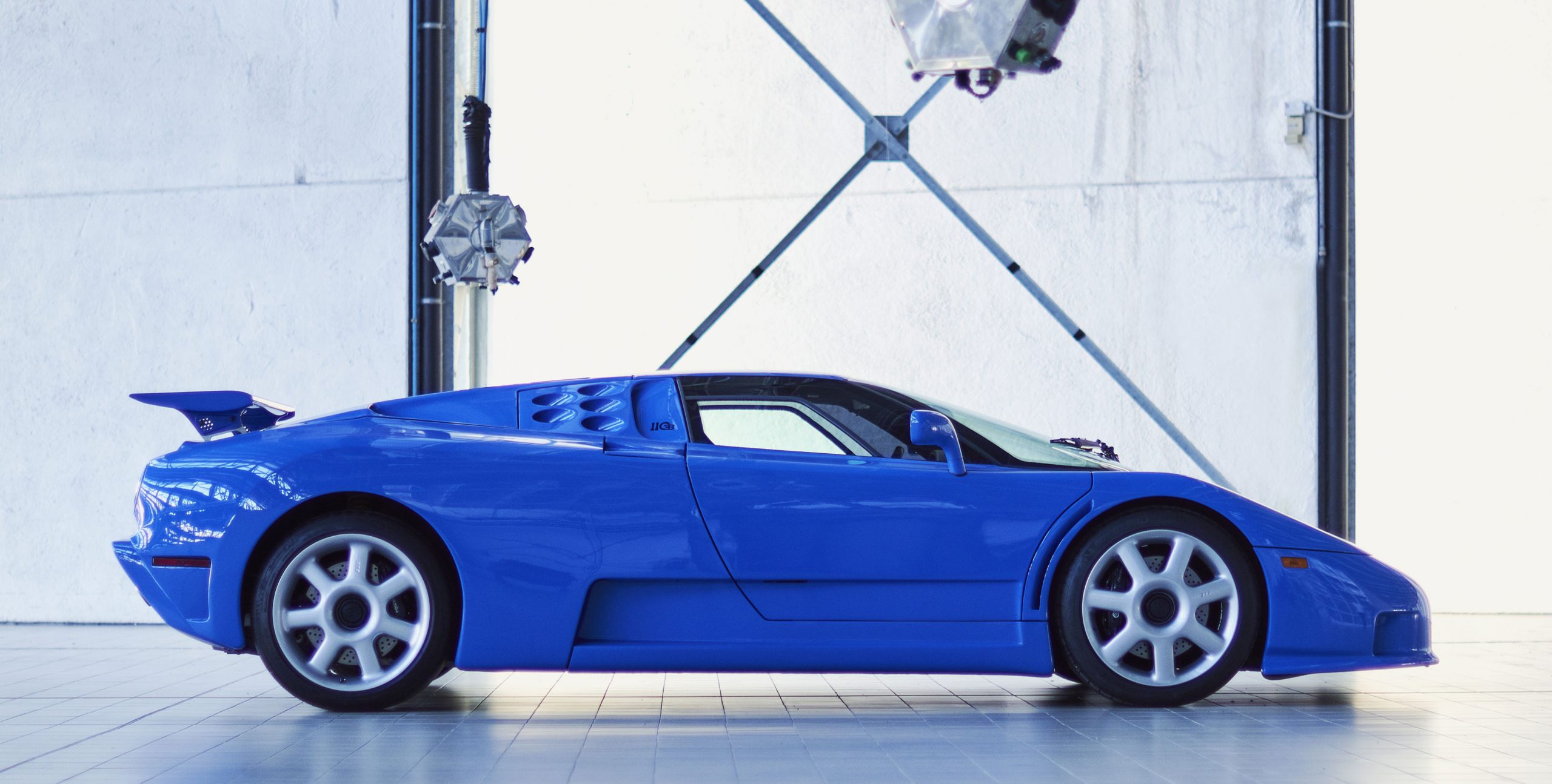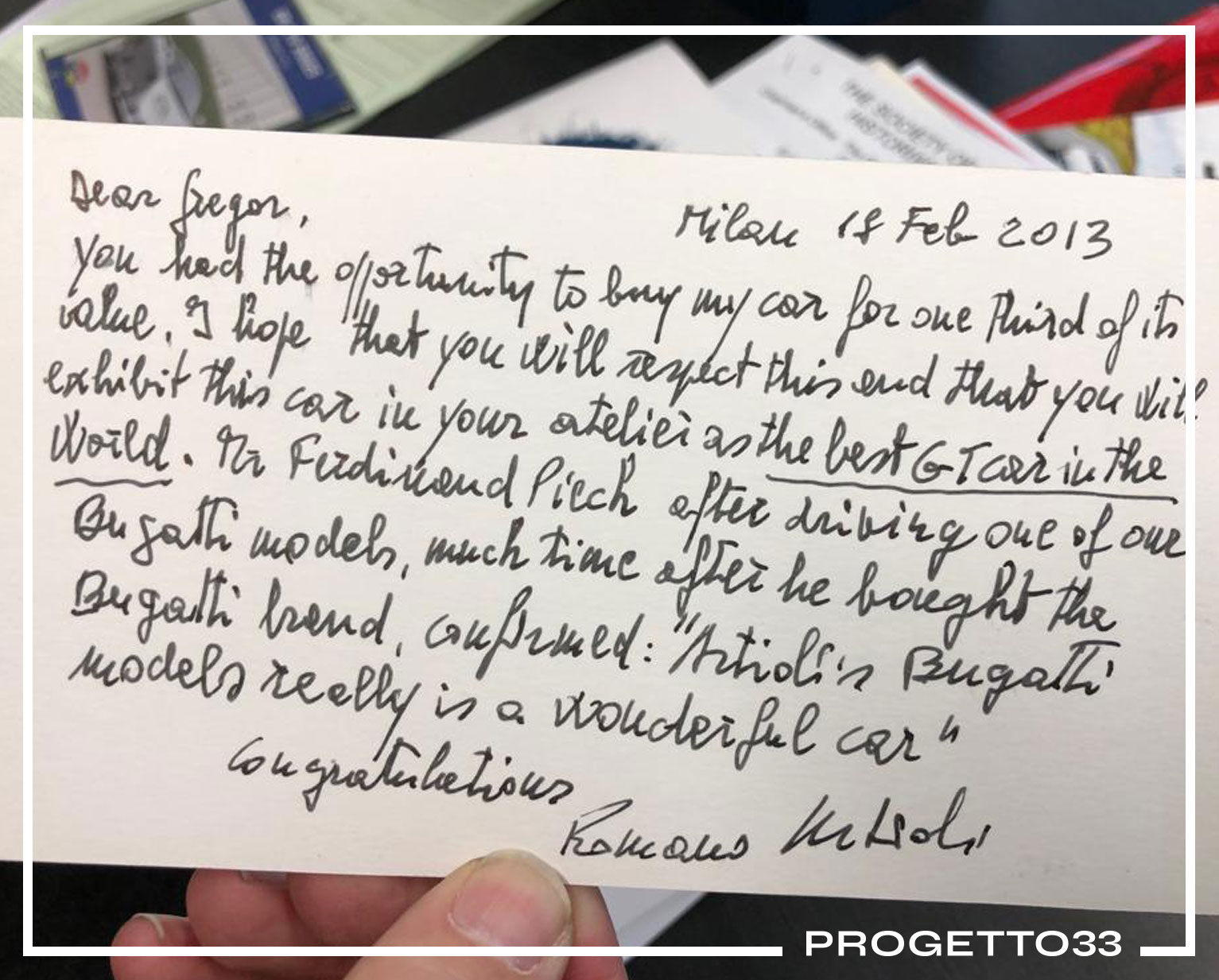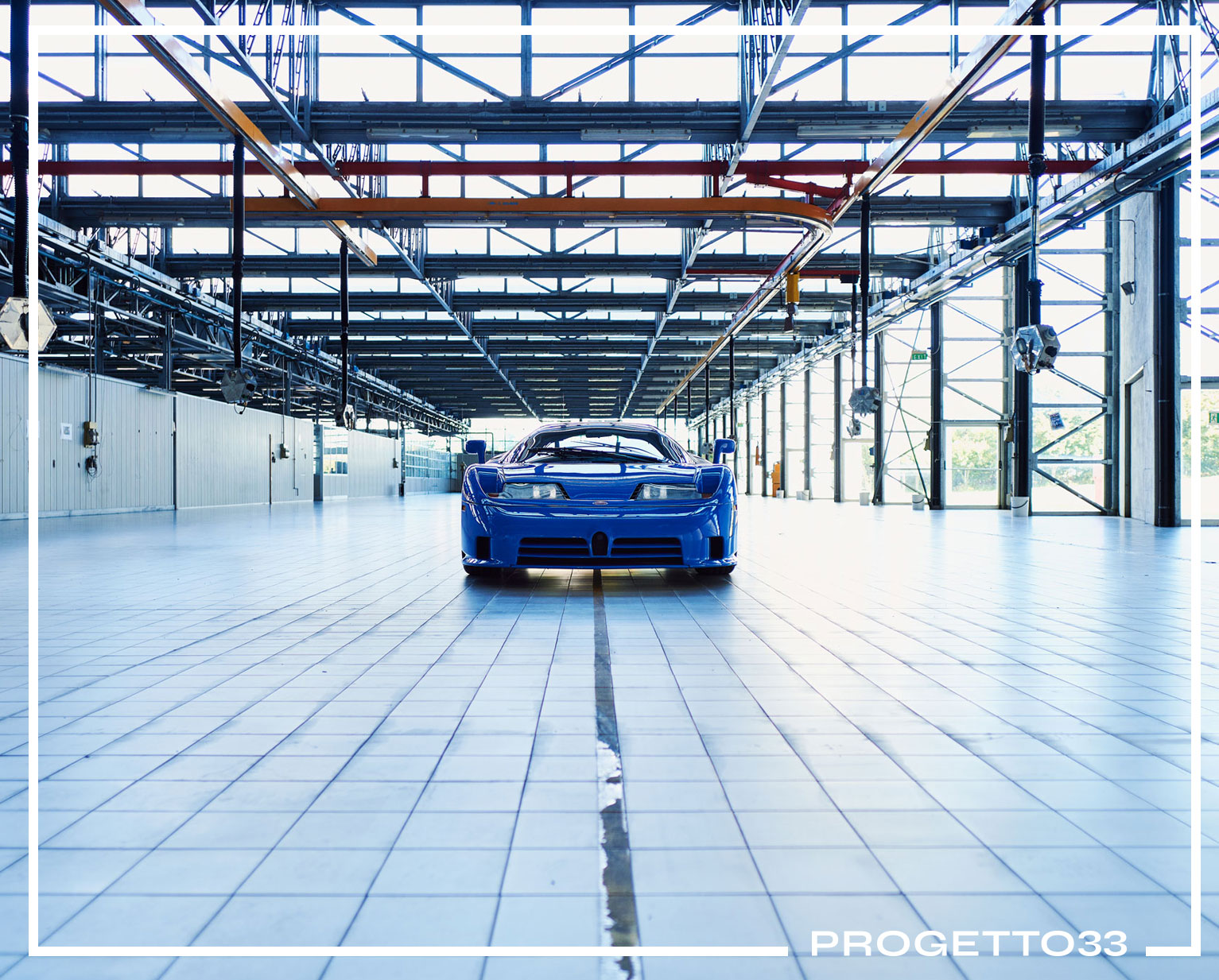

MODEL
BUGATTI EB110 AMERICA
YEAR
1994

Bugatti EB110 America: why this one?
Few contemporary cars will earn a place of honour in history. This is not a matter of insolence or snobbery for a specific era or brand. The benchmarks, standards or blue chips of vintage collecting are still the preserve of cars from selected eras, the 50s, 60s, 70s and even pre-war, and of these, only a few occupy the top positions, both because of their rich history and because the brands to which they belong have a tradition of being major players and will continue to be influential in the future. These include Ferrari first and foremost, but obviously not all Ferraris. These are followed by Porsche, Alfa Romeo, Maserati, Lamborghini, Mercedes, Bugatti, Jaguar and Aston Martin. These are all brands that have distinguished themselves in specific eras, or that have had more continuity in their results, often winning the laurels of victory in both racing, style, and in defining and influencing lifestyles. Jaguar and Aston Martin, for example, are focusing on new car ranges that are increasingly modern, but they are combining this with a strategy aimed at making customers feel the thrill of driving legendary cars that have written important pages in motorsport history. Giving continuity to their history, in particular to the younger generations, reviving the memory of the heroic days of racing and at the same time looking to the future. This is the so-called ‘Continuation‘ programme whereby, for example, Jaguar has reproduced the historic C-type and D-type cars in a small number of units (approx. 25 units) with a modern twist. Aston Martin is pursuing a similar strategy, making it possible to replace the original petrol engines (which are increasingly valuable) of its vintage models with electric motors without having to make drastic changes to the chassis and mechanics, and enabling it to have a completely reversible powertrain solution. This would make it possible to use classic cars even in an urban environment where there are driving restrictions for cars with internal combustion engines. An eye on the past with an eye to the future. And Bugatti? Unlike Ferrari, it has not shared the same fate and its existence has been inextricably linked to the fortunes of Ettore Bugatti and his family. Having stopped producing road cars back in 1953, in 1987 entrepreneur Romano Artioli acquired the brand from the French State and Bugatti returned to car production after just under 40 years. The 1990s were relatively scarce in novelties when compared to other, more creative decades. And yet, even in this period there were stars. In particular, one remained in the shadows for a long time, despite its many futuristic features. The Bugatti EB110. The car was named after the initials of its founder Ettore Bugatti and the 110th anniversary of his birth. A long-forgotten car, mainly due to the bankruptcy of Bugatti Automobili SpA in 1995. We will not dwell here on the events that led to this ending (which would not, however, lead to a new end for Bugatti), but certainly the power of the media had a decisive influence in directing the destiny of a more than valid car to the humiliation of oblivion, from which it seemed it would never be freed. Bugatti itself, today’s Bugatti Automobiles SAS, came to its aid. On the occasion of the one hundred and tenth anniversary of its foundation, La Marque recognised Bugatti Automobili SpA as an integral part of its cultural and productive heritage, and acknowledged the essential role played by the entrepreneur Romano Artioli in the rebirth of a marque that had not existed as an automotive brand for several decades.
In other words, without Artioli and Bugatti Automobili SpA, there wouldn’t be a revived Bugatti today. There is no doubt as to the revolutionary value of the Bugatti EB110’s contribution in terms of engine, chassis and general technology. Subjective opinions can be expressed on its styling, but it cannot be said that its sinuous, rounded forms, even if markedly sporty, do not belong to the stylistic elements of La Marque, with that small horseshoe-shaped grille testifying to its blue blood, to its belonging to the aristocracy of motor sport. Like all history-making Bugattis, it was innovative to the point that it implicitly set the design standard for road-going hypercars for years to come. Thirty years after its launch, the BMW i8, a plug-in hybrid with a carbon-fibre shell chassis, and Maserati’s most recent creation, the MC20, with a monocoque carbon-fibre chassis designed by Dallara are clear examples of this. The distortion of content in news items that weren’t always accurate or exhaustive, focusing too much on the hot contemporary issues rather than on the product itself, have in fact led to the EB110 being remembered as “The Forgotten Supercar“. A certainly bitter fate. It has taken almost 25 years since 1995, the year Bugatti Automobili SpA went bankrupt, for this error to be rectified and for the historical truth to be understood and spread that the Bugatti EB110 was in fact the initiator of a new way of conceiving the high-performance road car, the progenitor of an innovative new breed of hypercar. It can reasonably be considered fortunate that this was the case. In fact, despite the considerable amount of time that has passed, things may never have changed. Bugatti’s one hundred and tenth anniversary was simultaneously a celebration of its historical continuity and the EB110’s return to its rightful place in the automotive industry. Amongst all the EB110s, the story of a 1994 “Factory car” stands out, an SS (Sport Stradale), i.e. an improved, lightened and upgraded version. More agile and faster than the previous generation, the GT. The chassis number ended with 39025. It was a very special car, because it was one of the very few prototypes completed for the American market, assembled in accordance with the strict American regulations, so much so, for example, that the chassis number or VIN appeared on the windscreen in the lower corner, driver’s side, in compliance with the American federal laws on car homologation.
In 1994, Bugatti Automobili SpA prepared to enter the American market, mainly thanks to the Lotus distribution network, recently acquired by Romano Artioli. Starting with the SS range, this prototype was created. The engine was adapted to road use in the USA. For this reason, it was neither a GT nor an SS; it was an America. The Sport Stradale model was the first version to be adapted for the North American market. Modifications were numerous and included structural and impact elements. The nose of the car was revised to meet US safety standards, with changes to the chassis. Aesthetically, this translated into a Bugatti logo positioned higher up the nose, centrally just below the headlights, on a thin panel running transversely across the bodywork. The spoiler was modified, giving it a more fluid appearance than the European version, which conveys the feeling of an object fitted in a less harmonious manner. The car with chassis no. 39025, at the time made in light grey, was presented to the American public during the 1994 Italian Concorso in Monterey and won the “People’s Choice” trophy. At the beginning of 1995, it was the star of the Chicago Auto Show held in the first half of February. When the car returned from the USA at the end of its undoubtedly successful Press Tour, Romano Artioli decided to keep the car that symbolically represented the expected quantum leap for Bugatti in the world’s most important market for himself. Artioli passionately loved the Bugatti brand and a “pur sang” (full-blooded) Bugatti could only be blue. He therefore decided to entrust one of the world’s most renowned coachbuilders with the task of repainting the car. It was Andrea Zagato who gave the 39025 the Blu Bugatti livery that still dresses it today. This pantone of blue is unique and represents the quintessence of Bugatti’s blue blood. The 39025 thus became “The President’s car“. Artioli kept the 39025 for a long time at the Zagato showroom in Milan, together with various prototypes that made the bodywork so sought-after. Until 2013, the car remained in the Zagato Atelier until Artioli made the painful decision to part with it in order to take on new business projects. The 39025 was then put up for auction and sold to Gregor Fisken, who took care to maintain it adequately. The Bugatti EB110 was an absolute pioneer on the motorsport scene in the 1990s, innovative as the first road sports car to be equipped with a carbon-fibre tubular frame built in collaboration with the French company Aérospatiale, when no car manufacturer had yet had the necessary experience to tackle such a project. It was the first hypercar to employ permanent four-wheel drive and had exceptional handling, far superior to any other competitor at the time. Its 3500 cc, 12V engine was equipped with 5 valves per cylinder and 4 turbos. A refined and sophisticated engine that developed around 610 HP in the SS version. Its performance speaks for itself: 3.2 sec from 0-100km/h, the fastest ever at the time, and 351 km/h, again the fastest. Its lap record of 7.44 minutes on the Nordschleife in 1993 was only equalled in 2002. These are achievements that all EB110s have in common, especially in the SS version. This car in particular, however, holds unique trump cards. It was the car that brought the EB110 to global acclaim with the titles it won on the US Tour, garnering the support of the American public after its success in Europe.
Above all, it was the personal car of Romano Artioli, the visionary who is credited with bringing back to life one of the automotive brands that seemed consigned to history, destined only for memories and the sands of time for a substantial contribution to the technological development of the industry, thanks to its participation in competitions, and supported by the victories obtained under the guidance of Ettore Bugatti throughout the 20th century, but abruptly interrupted shortly after the second post-war period.
An icon of style and luxury associated with racing, the Bugatti brand was first brought back to life by Romano Artioli with a creation that proved to be a real “Point Break” with the past in terms of the conception, engineering and development of a high-performance car, and then rescued from a new financial ‘debacle’ thanks to a rescue operation undertaken by Artioli himself. With unwavering determination, Artioli brought in none other than Ferdinand Piëch, an equally iconic figure whose name is linked both to Porsche’s sporting glory and to the management of the Volkswagen Group. The great Austrian entrepreneur, a visionary in his own right, believed in the concept of the EB110 and that they could form the basis for Bugatti’s future. So, he took over the brand and put it under Volkswagen’s “protective wing“. Artioli’s goal was achieved, albeit with a different outcome than he had imagined. Bugatti survived and remains alive today. In 2019, Bugatti Automobiles dedicated an evocative model, the Centodieci, to the EB110 to mark the company’s 110th anniversary. An acknowledgment of this model and the man behind its genesis. In conclusion, the car we are discussing here is the exclusive witness to an ownership whose historical value transcends the typical valuation criteria for which importance is attached to this measure in a classic car. Without exaggeration, one can speak in this case of the ‘definitive ownership’, because in light of the above, there can be no greater ownership for an EB110. This adds uniqueness to rarity in the context of an entrepreneurial story of extraordinary intensity and courage, which does not end in a sad and surrendering conclusion with failure, but proceeds with flourish into the future with new vigour and renewed strength. Within the range of human endeavours known to the general public, Winston Churchill’s quotation fits perfectly : “Success is not final, failure is not fatal: it is the courage to continue that counts”. An essential part of this history certainly belongs to the EB110 America chassis number 39025 dressed in the most authentic Bugatti Blue.

History and Characteristics
The creation of the EB110 is the expression of an absolute. The Sport Stradale version represents the competitive frontier of this “absolute”. The EB110 Sport Stradale is a lightweight version of the EB110 which, with 611 PS of pure power, is designed for enthusiasts who want maximum performance from the car while retaining comfort and safety. Some features have been excluded or replaced, for example some bodywork elements are made of carbon fibre while some mechanical components of the engine and transmission are made of magnesium and titanium. The Sport Stradale boasts high performance and a thrilling ride, offering all the technical solutions that allow a substantial reduction in weight combined with an impressive increase in engine power. The EB110 Sport Stradale, qualifies as one of the world’s fastest production cars with a 0-100km/h time of just 3.26 seconds and an officially sanctioned top speed of 355km/h. Translated with www.DeepL.com/Translator (free version)

Photographer: Gabriele Spalluto




